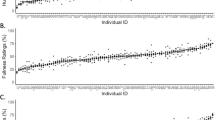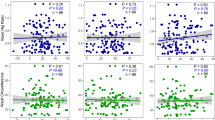Abstract
OBJECTIVE: To establish differences between lean and obese subjects in subjective reports of predominant taste and texture attributes of ‘foods as eaten’, and the relationships of these qualities to hedonic preference and objective measures of dietary intake and composition.
DESIGN: Free-living subjects received instruction in a laboratory and kept diaries of foods eaten at home.
SUBJECTS: 41 lean (body mass index (BMI) 20–25 kg/m2) and 35 obese (BMI≥30 kg/m2), non-dieting healthy adults.
MEASUREMENTS: Subjects kept four-day weighed dietary intake records, simultaneously assigning ratings for perceived pleasantness and predominant sensory attributes (taste and texture) of food eaten, and completed the Dutch Eating Behaviour questionnaire (DEBQ). Anthropometric measures included body composition assessed by bioelectrical impedance.
RESULTS: By all anthropometric measures (except height) the obese group was significantly larger than the lean group, but no significant differences were found for DEBQ scores. There were no significant group differences between pleasantness scores overall, nor for foods classified by predominant taste. Whilst macronutrient intakes did not differ, the obese group’s mean dietary energy density was significantly higher, and they reported significantly greater dietary energy from ‘salty’ foods. For the obese group, the percentage of ‘salty’ foods eaten correlated strongly with energy density. A strong positive association was found between ‘liking extremely’ and ‘sweet’ foods for the lean group, but no clear associations were found for any particular taste and hedonic rating for the obese group. Whilst both groups used similar texture descriptors, there were not clear or unambiguous differences in their assignment or association with other measures.
CONCLUSIONS: The results suggest that obese and lean subjects do not self-select diets with markedly different perceived sensory or hedonic attributes. However obese subjects appear to consume a diet higher in energy density, which is particularly associated with intakes of salty/savoury (rather than sweet) food items.
This is a preview of subscription content, access via your institution
Access options
Subscribe to this journal
Receive 12 print issues and online access
$259.00 per year
only $21.58 per issue
Buy this article
- Purchase on Springer Link
- Instant access to full article PDF
Prices may be subject to local taxes which are calculated during checkout
Similar content being viewed by others
Author information
Authors and Affiliations
Rights and permissions
About this article
Cite this article
Cox, D., Perry, L., Moore, P. et al. Sensory and hedonic associations with macronutrient and energy intakes of lean and obese consumers. Int J Obes 23, 403–410 (1999). https://doi.org/10.1038/sj.ijo.0800836
Received:
Revised:
Accepted:
Published:
Issue Date:
DOI: https://doi.org/10.1038/sj.ijo.0800836
Keywords
This article is cited by
-
Obesity-induced taste dysfunction, and its implications for dietary intake
International Journal of Obesity (2021)
-
The Impact of Physical Activity on Food Reward: Review and Conceptual Synthesis of Evidence from Observational, Acute, and Chronic Exercise Training Studies
Current Obesity Reports (2020)
-
Associations between liking for fat, sweet or salt and obesity risk in French adults: a prospective cohort study
International Journal of Behavioral Nutrition and Physical Activity (2016)
-
Multiple novel gene-by-environment interactions modify the effect of FTO variants on body mass index
Nature Communications (2016)
-
The Partner-Specific Sexual Liking and Sexual Wanting Scale: Psychometric Properties
Archives of Sexual Behavior (2012)



